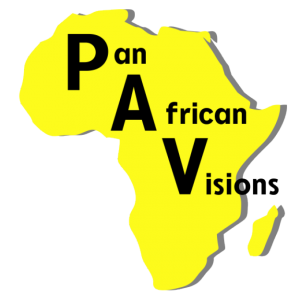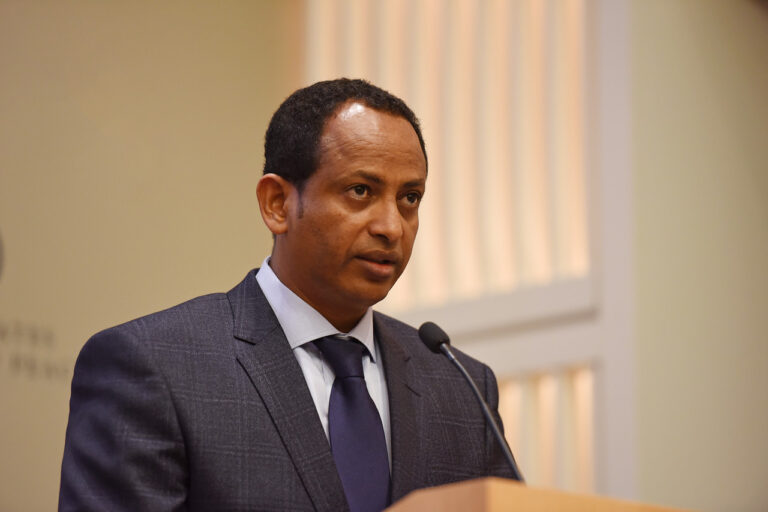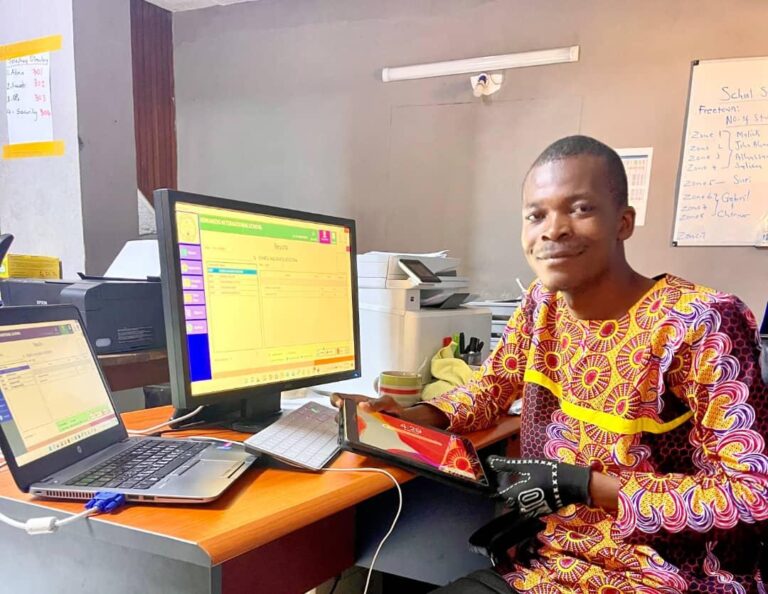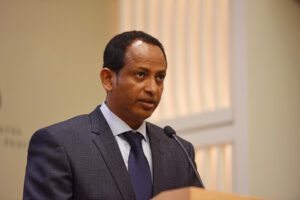STEM Education and African Development
November 04, 2015
By Dr Nkem Khumbah*
[caption id="attachment_22103" align="alignleft" width="300"] Dr Nkem Khumbah[/caption]
The current discussion of Africa’s heralded economic growth and rise as a world power is leading to increased optimism and self-confidence on the continent. The discussion has revolved around the need to strengthen its human capabilities to sustain such growth and ensure that the growth is accompanied by significantly less poverty and greater shared prosperity for the continent.
However, the foundations of the economic performance underlying this Africa rising phenomena are shallow. It has been predominantly based on the extraction of natural resources rather than an increase in productivity or expansion in economic sectors. Most African economies and societies continue to be dominated by the low-level processing of natural resources and the production of simple consumer goods for local consumption Their economies have remained substantially untransformed from the colonial phase of raw material production and export.
Over the last three decades, a global wave of market liberalization has produced an interconnected world economy that has brought unprecedented structural changes that have placed Nation’s abilities to master and utilize Science, Technology, Engineering and Mathematics (STEM) as key determinants of economic growth, development, and security.
In the 1960s and 1970s, many economies in South America –such as Argentina - enjoyed significant capital accumulation. But complacency and short-term approaches resulted in the failure to transition their economies to technological innovation as the basis for development.
At the same time countries such as South Korea, China, and Israel consciously decided to invest substantial government revenues in building world-class laboratories to support education and research in STEM, and to enable intellectual work and commercial exploitation of these subjects. After a generation of investment, they have seen enormous returns as evidenced by the growth of their STEM workforce, undergirding their emergence as major players in the global science-based economy. For example, Samsung of South Korea wields global prominence in electronics today, thanks to a workforce that includes over 40,000 engineers in Software development alone; China is able to leverage its large engineering workforce to establish its footprint in Africa, while some studies attribute between 50% and 85% of US GDP growth over the past 50 years to advancements in domestic science and engineering competencies.
As national abilities to master and utilize science to produce technologies that enable innovation have increasingly assumed determinative influence on economic development, Africa’s failure to re-balance its educational offerings from humanities and social sciences, towards STEM subjects constitute the most serious challenge to its ability to sustain its current economic growth and be one of the world’s leading continents in manufacturing and exports.
Comparative indicators of how Africa lags behind other regions of the world in scientific productivity and knowledge systems abound[1]. Problems with higher education institutional infrastructure inputs—such as electricity and water supply, staff shortages and ever-increasing enrollments due to fast growing youth population, research infrastructure, weak governance and quality assurance, and the many material challenges to Higher Education Institutions in Africa - are also well documented. Recent discourses about African Higher Education have tilted towards these material challenges, and less on the need to correct long-standing imbalances in the disciplinary offerings, to make up for long delays in developing STEM capabilities on the continent Even with prevailing challenges to Higher Education, Africa’s current stock of graduates with secondary- and tertiary-level skills is still highly skewed towards the humanities and social sciences, while the proportion of students in STEM averages less than 25 percent. After some 16 years of subsidized public education, these graduates face unemployment rates of up to 90% in some instances, while their countries continue to transfer major resources to expatriate countries for construction and maintenance of its public infrastructures because of the lack of a competent domestic STEM workforce; and at the end, the continued lack of domestic expertise means African countries cannot maintain their own infrastructures or develop new industries, lest they bring back the expatriates at more cost. For example, Nigeria requires 51,000 more engineers in its electric power infrastructure than it currently produces.
Further, the increasingly technical nature of many public and private sector international negotiations on subjects pertinent to Africa’s development and security -–such as climate change, trade and finance-- favors countries that use advanced scientific knowledge to inform their positions, further constraining Africa’s position in international affairs and trade.
African Political leadership has yet to embrace the STEM Education imperative for transforming African society with the enthusiasm it deserves; and policies aimed at addressing Africa’s long term prospects in STEM needs to be situated within a global context, to better appreciate all the actors and forces influencing its development, as well as the level of attention and effort required for meaningful progress.
Nations that have developed high technological capacities understand the importance of world-class STEM education all too well, and they are increasingly strengthening their scientists and STEM institutions to build strong reputations and compete for the best international students, faculty, and resources. These countries have developed ever-stronger strategies for STEM education and research, as measured by their investment levels in these areas. They are also offering attractive opportunities, as employers worldwide are projected to face a shortage of over 85 million high- and medium-skilled STEM workers by 2020.
African leaders’ increasing vocal support for STEM on the international stage has provided a welcome and much-needed boost for science on the continent. However, the dangers of superficiality and short-term approaches threaten the sustained and long-term planning that is requisite for any meaningful transformation of the sector. Indeed, purposeful funding for science is either meager or absent in many African countries, while some non-Africa countries dedicate as much as 4% of their GDPs to scientific research (the average of top 40 national annual budgetary allocations to STEM R&Dis $40 Billion). The effect is a widening gap between Africa’ STEM progress and that of more advanced countries, thus exacerbating prevailing disparities in income and development, amidst Africa’s positive economic “performance.”
Heavy reliance on international expertise and funds results in STEM development in Africa being shaped mostly by international donor and bilateral and multilateral partnerships (e.g. US-based Foundations, the European Union–Africa Joint Strategy, the India–Africa Science and Technology Initiatives and the China–Africa Science and Technology Partnership). While these instruments bring much needed goodwill, expertise and finances in support of African development, with over half of all STEM funding coming from international partners, most of current implementation mechanisms are not structured to promote African ownership, accountability and sustainability.
The heavy influence of international agencies on STEM activity in Africa also tends to fragmentize inter-African research communities, with each of the sub-regions collaborating more with international partners and less with one another, as measured through their publications output. Inter-African collaborations (collaborations without any South-African or international collaborator) comprise just 2%, 0.9%, and 2.9% of all East African, West & Central African, and Southern African total research output.
In contrast, 40% to 80% of African Regional STI publications are with external partners, with the majority in fields of most interest to international donors, such as Health and Agriculture. While these areas are of primary importance to Africa, heavy donor influence in these areas has also meant research and education activity in other complementary areas necessary to enable Africa develop a vibrant fundamental STEM space – such as frontier physics, mathematics and computer science—are neglected, or practically nonexistent. With its vast extractive resources and activity, there is hardly any activity in complementary Engineering disciplines, effectively depriving Africa from engaging in STEM research and knowledge systems that could derive from strategic advantages in associated extractive industries.
If Africa is to realize its aspirations contained in the African Union’s continental agenda 2063 and Science, Technology, Innovation Strategy for Africa (STISA), its governments have to forcefully revitalize their higher education systems towards STEM Education, as the next – even pivotal-- frontier in the continent’s historical evolution. It is the caliber of its university graduates in STEM fields that will produce and manage the knowledge that will give relevance to its other institutions – governance, trade, defense, agriculture, health, finance, energy and diplomacy. It is through a vitalized STEM Education that Africa may turn its increasing demographics into a dividend to enhance its democracies.
A way to start is for African nations and regional economic communities to establish STEM Education and Research Strategies. This will entail prescient and deliberate policies to identify and invest in select universities as national and continental assets ―perhaps their most potent assets, and as the most important ingredients in continental development objectives. The Korean Advanced Institute of Science and Technology (KAIST) and its symbiotic relationship with the modern South Korean economy is exemplary. The strategy may include investments to transform select Technical and Vocational Institutions into elite selective STEM-focused secondary schools that will train highly motivated and able students, and focus on preparing them for ambitious post secondary study and STEM careers.
Youth employability, development of a STEM workforce and industrial transformation together present common challenges, with implications for STEM education that can neither be fully defined nor addressed by the public policy sector, the university systems or the business sectors alone in isolation. These challenges are best addressed by the creation of appropriate and highly effective interface between government bodies that make policies, the university community that trains the workforce, and the business community that absorbs university graduates and translates research products into improvements of the economic and social sectors.
Policy makers are best positioned to institute such an interface as an ongoing convening of leadership from all three sectors – government, university, and industry – to dialogue candidly, co-define common problems and craft overarching solutions, and to commit these three communities to co-forge and co-champion execution of solutions to these common problems. Such a convening will serve to catalyze support and action across government, university, and industry to meet Africa’s critical science and technology needs for the much-desired science-led economic transformation and graduates employability.
While specific African STEM initiatives—such as networks and Centers of Excellence— enable important concrete development at varying levels of impact, the vitality, stature and utility of each STEM disciplinary enterprise (such as Physics, computer science, Engineering, etc.) depends on the space it occupies on the regional spectrum of competing interests, respectability, and resource allocation in the Higher education sector.
*Original Article published in Africa Policy Review , Follow the author on twitter
Dr Nkem Khumbah[/caption]
The current discussion of Africa’s heralded economic growth and rise as a world power is leading to increased optimism and self-confidence on the continent. The discussion has revolved around the need to strengthen its human capabilities to sustain such growth and ensure that the growth is accompanied by significantly less poverty and greater shared prosperity for the continent.
However, the foundations of the economic performance underlying this Africa rising phenomena are shallow. It has been predominantly based on the extraction of natural resources rather than an increase in productivity or expansion in economic sectors. Most African economies and societies continue to be dominated by the low-level processing of natural resources and the production of simple consumer goods for local consumption Their economies have remained substantially untransformed from the colonial phase of raw material production and export.
Over the last three decades, a global wave of market liberalization has produced an interconnected world economy that has brought unprecedented structural changes that have placed Nation’s abilities to master and utilize Science, Technology, Engineering and Mathematics (STEM) as key determinants of economic growth, development, and security.
In the 1960s and 1970s, many economies in South America –such as Argentina - enjoyed significant capital accumulation. But complacency and short-term approaches resulted in the failure to transition their economies to technological innovation as the basis for development.
At the same time countries such as South Korea, China, and Israel consciously decided to invest substantial government revenues in building world-class laboratories to support education and research in STEM, and to enable intellectual work and commercial exploitation of these subjects. After a generation of investment, they have seen enormous returns as evidenced by the growth of their STEM workforce, undergirding their emergence as major players in the global science-based economy. For example, Samsung of South Korea wields global prominence in electronics today, thanks to a workforce that includes over 40,000 engineers in Software development alone; China is able to leverage its large engineering workforce to establish its footprint in Africa, while some studies attribute between 50% and 85% of US GDP growth over the past 50 years to advancements in domestic science and engineering competencies.
As national abilities to master and utilize science to produce technologies that enable innovation have increasingly assumed determinative influence on economic development, Africa’s failure to re-balance its educational offerings from humanities and social sciences, towards STEM subjects constitute the most serious challenge to its ability to sustain its current economic growth and be one of the world’s leading continents in manufacturing and exports.
Comparative indicators of how Africa lags behind other regions of the world in scientific productivity and knowledge systems abound[1]. Problems with higher education institutional infrastructure inputs—such as electricity and water supply, staff shortages and ever-increasing enrollments due to fast growing youth population, research infrastructure, weak governance and quality assurance, and the many material challenges to Higher Education Institutions in Africa - are also well documented. Recent discourses about African Higher Education have tilted towards these material challenges, and less on the need to correct long-standing imbalances in the disciplinary offerings, to make up for long delays in developing STEM capabilities on the continent Even with prevailing challenges to Higher Education, Africa’s current stock of graduates with secondary- and tertiary-level skills is still highly skewed towards the humanities and social sciences, while the proportion of students in STEM averages less than 25 percent. After some 16 years of subsidized public education, these graduates face unemployment rates of up to 90% in some instances, while their countries continue to transfer major resources to expatriate countries for construction and maintenance of its public infrastructures because of the lack of a competent domestic STEM workforce; and at the end, the continued lack of domestic expertise means African countries cannot maintain their own infrastructures or develop new industries, lest they bring back the expatriates at more cost. For example, Nigeria requires 51,000 more engineers in its electric power infrastructure than it currently produces.
Further, the increasingly technical nature of many public and private sector international negotiations on subjects pertinent to Africa’s development and security -–such as climate change, trade and finance-- favors countries that use advanced scientific knowledge to inform their positions, further constraining Africa’s position in international affairs and trade.
African Political leadership has yet to embrace the STEM Education imperative for transforming African society with the enthusiasm it deserves; and policies aimed at addressing Africa’s long term prospects in STEM needs to be situated within a global context, to better appreciate all the actors and forces influencing its development, as well as the level of attention and effort required for meaningful progress.
Nations that have developed high technological capacities understand the importance of world-class STEM education all too well, and they are increasingly strengthening their scientists and STEM institutions to build strong reputations and compete for the best international students, faculty, and resources. These countries have developed ever-stronger strategies for STEM education and research, as measured by their investment levels in these areas. They are also offering attractive opportunities, as employers worldwide are projected to face a shortage of over 85 million high- and medium-skilled STEM workers by 2020.
African leaders’ increasing vocal support for STEM on the international stage has provided a welcome and much-needed boost for science on the continent. However, the dangers of superficiality and short-term approaches threaten the sustained and long-term planning that is requisite for any meaningful transformation of the sector. Indeed, purposeful funding for science is either meager or absent in many African countries, while some non-Africa countries dedicate as much as 4% of their GDPs to scientific research (the average of top 40 national annual budgetary allocations to STEM R&Dis $40 Billion). The effect is a widening gap between Africa’ STEM progress and that of more advanced countries, thus exacerbating prevailing disparities in income and development, amidst Africa’s positive economic “performance.”
Heavy reliance on international expertise and funds results in STEM development in Africa being shaped mostly by international donor and bilateral and multilateral partnerships (e.g. US-based Foundations, the European Union–Africa Joint Strategy, the India–Africa Science and Technology Initiatives and the China–Africa Science and Technology Partnership). While these instruments bring much needed goodwill, expertise and finances in support of African development, with over half of all STEM funding coming from international partners, most of current implementation mechanisms are not structured to promote African ownership, accountability and sustainability.
The heavy influence of international agencies on STEM activity in Africa also tends to fragmentize inter-African research communities, with each of the sub-regions collaborating more with international partners and less with one another, as measured through their publications output. Inter-African collaborations (collaborations without any South-African or international collaborator) comprise just 2%, 0.9%, and 2.9% of all East African, West & Central African, and Southern African total research output.
In contrast, 40% to 80% of African Regional STI publications are with external partners, with the majority in fields of most interest to international donors, such as Health and Agriculture. While these areas are of primary importance to Africa, heavy donor influence in these areas has also meant research and education activity in other complementary areas necessary to enable Africa develop a vibrant fundamental STEM space – such as frontier physics, mathematics and computer science—are neglected, or practically nonexistent. With its vast extractive resources and activity, there is hardly any activity in complementary Engineering disciplines, effectively depriving Africa from engaging in STEM research and knowledge systems that could derive from strategic advantages in associated extractive industries.
If Africa is to realize its aspirations contained in the African Union’s continental agenda 2063 and Science, Technology, Innovation Strategy for Africa (STISA), its governments have to forcefully revitalize their higher education systems towards STEM Education, as the next – even pivotal-- frontier in the continent’s historical evolution. It is the caliber of its university graduates in STEM fields that will produce and manage the knowledge that will give relevance to its other institutions – governance, trade, defense, agriculture, health, finance, energy and diplomacy. It is through a vitalized STEM Education that Africa may turn its increasing demographics into a dividend to enhance its democracies.
A way to start is for African nations and regional economic communities to establish STEM Education and Research Strategies. This will entail prescient and deliberate policies to identify and invest in select universities as national and continental assets ―perhaps their most potent assets, and as the most important ingredients in continental development objectives. The Korean Advanced Institute of Science and Technology (KAIST) and its symbiotic relationship with the modern South Korean economy is exemplary. The strategy may include investments to transform select Technical and Vocational Institutions into elite selective STEM-focused secondary schools that will train highly motivated and able students, and focus on preparing them for ambitious post secondary study and STEM careers.
Youth employability, development of a STEM workforce and industrial transformation together present common challenges, with implications for STEM education that can neither be fully defined nor addressed by the public policy sector, the university systems or the business sectors alone in isolation. These challenges are best addressed by the creation of appropriate and highly effective interface between government bodies that make policies, the university community that trains the workforce, and the business community that absorbs university graduates and translates research products into improvements of the economic and social sectors.
Policy makers are best positioned to institute such an interface as an ongoing convening of leadership from all three sectors – government, university, and industry – to dialogue candidly, co-define common problems and craft overarching solutions, and to commit these three communities to co-forge and co-champion execution of solutions to these common problems. Such a convening will serve to catalyze support and action across government, university, and industry to meet Africa’s critical science and technology needs for the much-desired science-led economic transformation and graduates employability.
While specific African STEM initiatives—such as networks and Centers of Excellence— enable important concrete development at varying levels of impact, the vitality, stature and utility of each STEM disciplinary enterprise (such as Physics, computer science, Engineering, etc.) depends on the space it occupies on the regional spectrum of competing interests, respectability, and resource allocation in the Higher education sector.
*Original Article published in Africa Policy Review , Follow the author on twitter



























Thank you Dr. Khumba for that very candid piece.
I hope the policy makers are listening.
This is a wonderful contribution to the ongoing debate on the fact that Africa needs to sit up and rethink its strategies on what she can contribute to make her impact more felt in the global market.perhaps rather than always satisfying herself as the supplier of raw material, if she could venture on finished goods production, this may be the beginning of a fruitful journey in the morning